Abstract
This paper aims to investigate greenhouse gas emissions (GHGEs) in conflict areas, emphasising Palestine. This estimation faces several difficulties, particularly in data collection. The paper first presents the geopolitical context of Palestine and its consequences for the analysis of GHGEs. Then, it presents the estimation of the GHGEs related to energy, which constitutes the major contributor to GHGEs in Palestine. The emissions were estimated according to Tier 1 in the 2006 IPCC guidelines. For the first time in Palestine, (i) the International Energy Agency methodology for calculating emission factors from electricity consumption is used to estimate the emission factors of GHG at the final point of consumption, and (ii) the scope 2 emissions from imported electricity are accounted for in the total emissions. The GHGEs from the Palestinian electricity generation (excluding imported electricity) were 446,471 tons of CO2eq in 2019, representing 11% of the total emissions from the energy sector. The total GHGEs from electricity final consumption (including imported electricity) in all sectors were 3,929,829 tons of CO2eq. More than 60% (2,316,465 tons of CO2eq) of these emissions were attributed to the consumption of electricity by the households. Emissions from fuel consumption in 2019 were about 3,912,566 tons of CO2eq. Transport was found to be the main emitter of GHGs, with more than half of the total emissions (2,207,834 tons of CO2eq). Considering imported electricity in estimating the total GHGEs from the energy sector doubled the emissions. It increased the share of household emissions in the total GHGEs from the energy sector to become the most significant contributor to the total emissions.
1. Introduction
This paper estimates greenhouse gas emissions (GHGEs) from the energy sector in Palestine. This research is significant because it combines several challenges for assessing GHGEs, including data availability, territorial fragmentation, strong dependency and interaction with other countries, and its complex geopolitical context.
Palestine has been deprived from control over its international borders and submitted to discriminatory practices, including restrictions on the movement of people and goods, import of dual-use materials, access to natural resources, and destruction of property and infrastructure [1].
This subject is particularly significant because the consequences of the conflict in Palestine go beyond adding complication to carbon accounting to restricting Palestine’s mitigation and adaptive capacities to reduce GHGEs. Moreover, it raises complex questions regarding GHGEs: Who is responsible for these emissions? What is the legal point of view?
Few scholars have covered GHGEs in conflict areas with an emphasis on quantifying GHGEs in the context of armed conflicts and military operations [2,3,4]. Other scholars focused on emissions from energy generation in conflict areas such as Iraq and Syria, without discussing the implications of the war and conflict on this sector and its associated carbon emissions [5,6,7].
In terms of responsibility, a few researchers have discussed the responsibility of GHGEs in conflict areas. Michaelowa et al. (2022) and Michaelowa and Koch (2001) [8,9] established a general frame for the primary assignment of responsibility for military and conflict-related emissions in war and peacetime. They distinguished different types of conflicts, including the occupation, such as the case of Palestine.
In Palestine, there is a lack of published literature on GHGEs. Only one paper concerned carbon emissions from the energy sector [10]. In this paper, the emissions from electricity consumption were not considered. These emissions in Palestine lie under scope 2 emissions since the vast majority of the electricity in the country is imported because of political and logistical factors. Another study focused on emissions from household energy consumption. Abu-Madi and Rayyan (2013) [11] used emission factors from the published literature to estimate GHGEs from fuel consumption in the residential sector, including electricity, due to the unavailability of country-specific data. Other scholars estimated GHGEs from the transport sector [12,13,14,15]. These papers did not consider the impact of the conflict on GHGEs.
This paper fills this gap by considering the impact of the occupation on estimating the GHGEs in Palestine. The research question is then to collect available data on GHGEs and the occupation’s restrictions on Palestinians to analyse the impact of this occupation on the GHGEs in Palestine, with an emphasis on the energy sector.
This paper is composed of four main sections. It starts with the introduction, which presents the research gap and the research objective. Then, it describes the research methodology, including information on the study area, data collection, and the method of analysis. After that, it presents the research results, supported by a discussion. Lastly, the paper ends with the conclusions and limitations of this research.
2. Materials and Methods
2.1. Overview
The main objective of this paper is to present the impact of the conflict in Palestine on estimating GHGEs related to the energy sector, which constitutes the most significant contributor to carbon emissions according to the State of Palestine’s Initial National Communication Report (INCR) submitted to the United Nations Framework Convention on Climate Change (UNFCCC) [16].
The methodology adopted in this research is based on the IPCC-2006 guidelines, considering the 2019 refinement, which was adopted and accepted in the 49th session of the IPCC in May 2019. This research also covers indirect carbon emissions from imported electricity, unlike the National Inventory Reports (NIR), which only cover the direct emissions following the IPCC guidelines. This production-based carbon accounting method does not require reporting scope 2 emissions. The theoretical framework of this research is presented in Figure 1.
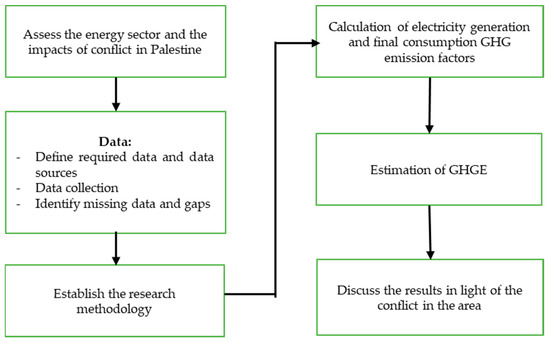
Figure 1.
Theoretical framework of the study.
The first step of this research included a study of the energy sector in Palestine with a focus on the impact of the conflict on GHGEs related to energy.
Data required to estimate GHGEs were defined according to the literature and the 2006 IPCC guidelines. Generally, to quantify CO2 emissions, two types of data are required: (i) activity data and (ii) emission factors. To reduce climate change caused by carbon emissions, it is imperative to estimate the emissions of GHGs [17,18,19]. The emission factors are coefficients that represent the average emission rate of a GHG from fuel combustion in particular activities/processes [20,21]. In the energy sector, the activity data are typically the amounts of fuels combusted in a specific activity/process. In this study, the activity data were characterised by fuel sales and electricity consumption by different sectors. It was a big challenge to obtain these data for Palestine. Data were acquired from different governmental and official bodies in the country, such as the Palestinian Energy and Natural Resources Authority (PENRA), the Palestinian Ministry of Transport (MoF), and the Palestinian Central Bureau of Statistics (PCBS). The geopolitical separation between the West Bank and Gaza Strip created difficulties in data collection.
Regarding emission factors, Palestine lacks country-specific emission factors due to the unavailability of expertise and equipment needed to measure these factors. Consequently, the default emission factors of the 2006 IPCC guidelines were applied. In particular, the emission factors of electricity consumption were estimated on the basis of the electricity generation emission factors. The emission factors for imported electricity were obtained from the Israel Central Bureau of Statistics, the Israel Ministry of Environmental Protection, and the Ministry of Energy and Infrastructure.
The last phase of this research estimates the GHGEs from fuel combustion using the collected data and emission factors based on Tier 1 in the IPCC guidelines and interprets the results in light of the conflict in the country. The use of Tier 1 is justified by data availability in the studied area, which did not allow us to use a higher tier. The next section provides more information about the research methodology.
2.2. Study Area
The study area covers the West Bank (including East Jerusalem) and Gaza Strip. According to the Oslo Accords (the Declaration of Principles on Interim Self-Government Arrangements of 1993 (Oslo I) and the Interim Agreement on the West Bank and the Gaza Strip of 1995 (Oslo II)), the West Bank was divided into three non-contiguous regions: A, B, and C [22]. Area A represents 18% of the West Bank, and most affairs in this area are controlled by the Palestinian Authority. Area B comprises 21% of the West Bank. The Palestinian Authority is in charge of civil administration in this area (education, health, and the economy), while Israel has complete control of the security. Area C represents the largest part of the West Bank (60%). It is under the control of Israel. Although the Oslo Accords were agreed to be an interim 5 year agreement, they are still in force. Additionally, there are at least 250 settlements in the occupied West Bank, which are home to around 500 thousand settlers [23], contributing significantly to air, soil, and water pollution in the West Bank [24,25].
The Palestinian economy strongly depends on the occupation due to restrictions on the movement of goods and people, import and export of dual-use materials and equipment, raw materials, and products, complete control of international borders, and the development of domestic and industrial infrastructure. Palestine depends strongly on neighbouring countries. For example, more than 95% of the electricity in the country is purchased due to political and logistical factors [22].
The illegal settlements, along with the apartheid wall, annexation, fragmentation, checkpoints, unequal status quo, and other discriminatory practices, reduce the adaptation capacity of the Palestinians to climate change. Adaption options that need the import of new technology, dual-use materials, and the development of infrastructure are challenging and require the lifting of these restrictions [1].
2.3. Energy Sector
Due to political and logistical factors, Palestine depends primarily on imported energy. Since Israel controls the energy imports, the energy sector suffers from an unsecured supply [10]. Figure 2 shows the main energy products, solid and liquid fuel, and electricity consumed by Palestinians in 2019, including and excluding imported electricity. The amounts of diesel and gasoline fuels transformed into electricity in energy industries (electricity power plants) in Palestine were excluded from the total amounts of diesel and gasoline fuels represented in Figure 2 to avoid double counting.
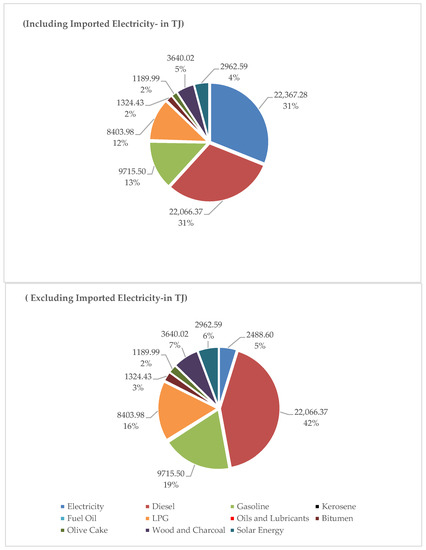
Figure 2.
Main energy products used in Palestine in 2019, including and excluding imported electricity (in TJ).
The primary fuels in Palestine include diesel, gasoline, LPG, wood, and charcoal. Transport and household sectors are considered the country’s largest fuel consumers [26]. Most of the consumed fuels in Palestine are imported except for the olive cake, wood, and charcoal [26]. In contrast, all of the liquid fuel is supplied by or via Israel and distributed to the consumers in Palestine by national suppliers [10].
In terms of electricity, more than 90% of the total supply is imported from Israel Electric Corporation (IEC) [27]. Local suppliers and Jordan and Egypt provide the remaining percentage of the supply. Figure 3 illustrates the electricity supply in Palestine in 2019. The Gaza Strip imports represent about 60–65% of the total supply, while the West Bank imports almost 98% of the electrical supply from IEC. This is because Palestine’s only generation power plant is located in Gaza. This power plant is diesel-fired with a generation capacity of approximately 60–140 MW [27]. Palestine is developing a new combined cycle gas-fired power plant with about 450 MW of generation capacity in Jenin City in the West Bank, which is supposed to cover 50% of the current electricity demand in Palestine [16]. The new power plant is expected to operate by the end of 2023.
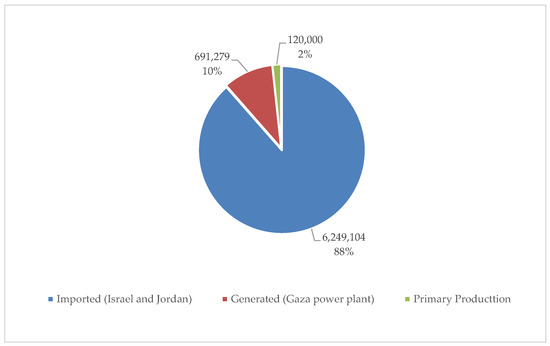
Figure 3.
Available electricity for consumption in Palestine in 2019 (in MWh).
Electricity represents about 30% of the total energy consumption in Palestine. It is dominated by the household sector [26]. Up to 2017, electricity was imported from Israel to Palestine using more than 270 connection points of low and medium voltage. Later, Palestine improved its power supply by adding four higher-voltage substations, which increased the capacity of imported electricity by 550 MW. The first high-voltage substation was implemented in 2017, and the other three substations followed in 2020. Transmitting the power at higher voltage has reduced losses and improved cost recovery by billing for a larger portion of imported electricity [27].
In most countries, power generation is a primary source of GHGEs. However, this is not the case in Palestine because a significant ratio of electric power is imported, which makes power generation insignificant for GHGEs [28]. According to the Palestinian references, the associated GHGEs with imported electricity are accounted for in Israel’s national GHG inventory [16]
Unlike the national GHG emission inventories submitted to the UNFCCC, this research estimates the GHGEs not only from electricity generation but also from total consumed electricity, locally generated and imported, which means it includes scope 2 emissions associated with the consumption of purchased electricity and heat.
2.4. Data Source
The estimation of GHGEs from fuel combustion activities requires (i) emission factors of GHGs, and (ii) detailed activity data on energy consumption in different sectors: energy industries, manufacturing industries, and construction, transport, and other sectors (commercial and institutional, residential, and agriculture/forestry/fishing). Therefore, data for this study were collected from different sources, as illustrated in Table 1.

Table 1.
Data collected, arranged by source.
Data on energy consumption were collected from the official reports of energy and energy balance in Palestine published by the PCBS [43]. The reports provide data on imported energy in Palestine, source and amounts of consumed electrical energy, type and amount of fuel used in electricity generation, and energy balance tables in Palestine, which provide detailed information on the total energy supply and final energy consumption by type of energy (electricity, diesel, gasoline, kerosene, fuel oil, liquefied petroleum gas (LPG), olive cake, and wood and charcoal) and energy subsectors: (i) energy industries, (ii) manufacturing industries and construction, (iii) transport and households, and (iv) other sectors (households, agriculture and commerce, and public services). The PCBS prepares these reports annually. Data were collected from the Palestinian Energy and Natural Resources Authority (PENRA), the Palestinian General Petroleum Corporation, PCBS Database of Foreign Trade. These data are considered high-quality; wherever any assumptions are made, missing data or parts of the country are not included (such notes are highlighted in the report). For instance, in the energy balance tables, the following assumptions were made:
- The technical losses in electricity in Palestine are considered to be 12%, according to the Palestinian Energy and Natural Resources Authority.
- The efficiency of the solar water heater was considered to be 45%, and the consumed energy was half of the produced quantity.
- In all accounts related to charcoal and wood, a unified calorific value was used for each charcoal and wood based on the weight of each type in the balance. The calorific value for both was considered to be 15.7 GJ/t.
Data on fuel characteristics in Palestine were used to convert the consumed fuel from physical units (kilogram, ton, litre) to energy units (joule). The data were collected from the Palestinian published literature [39,40,41,42], where different representative samples of fuel were examined, and the results were verified through comparison with standard fuel characteristics and the global published literature.
Transportation statistics were obtained from the Palestinian Ministry of Transport (MoT). They provide information on the number of vehicles by type of vehicle and fuel [31]. The data are considered of high quality; however, they do not include the Gaza Strip. Data for the Gaza Strip were obtained from the annual statistical and progress reports of the MoT in the Gaza Strip, which are available on the ministry’s official website [33].
To estimate the GHGEs from energy consumption, the default emission factors in the 2006 IPCC guidelines were used due to the unavailability of country-specific emission factors. Emission factors were selected according to the activity data and fuel type, as explained in detail in the 2006 IPCC guidelines. To estimate the emission factors from electricity generation and final consumption, it was necessary to distinguish two sources of electricity, imported and domestically generated electricity. In the case of locally generated electricity, default emission factors for diesel and gasoline (the electricity generation mix) were used. Regarding imported electricity, it was assumed that all the imported electric power was purchased from Israel (because more than 98% of purchased electricity in 2019 was from Israel) [26]. Israel’s electricity generation emission factors were obtained from the official reports on the State of the electricity Sector by the Electricity Authority in Israel [38]. According to the reference, the emission factors of electricity generation in Israel were calculated using country-specific emission factors and considering all suppliers of electric power and the different generation mix at each supplying point.
2.5. Estimation of GHGEs
The GHGEs from the energy sector were estimated from the primary energy products, including electricity. Since the electricity is transformed/generated from various primary energy sources such as natural gas, gasoline, and kerosene, the amounts of primary energy products which are used in the electricity generation were deducted from the total amount of fuel consumed by different sectors in the country, so that no double counting occurred in the estimation of CO2 emissions. This section provides a detailed explanation of the method of GHGE estimation from energy products starting with primary fuel and then electricity.
2.5.1. Fuel
The emissions generated from the combustion of different fuels in each sector were calculated separately. To estimate the emissions from any fuel, it is necessary to convert the amount of fuel from physical units (e.g., litre, kilogram, and ton) to energy units (joule). In this conversion, where possible, country-specific fuel characteristics are used. The density of diesel and gasoline was obtained from a published study that examined the fuel characteristics at nine gas stations in Palestine. The average densities of diesel and gasoline at the nine gas stations were 0.748 kg/L and 0.833 kg/L, respectively [42]. A net calorific value of 19.21 TJ/Gg was used for the olive cake. This value was based on studies in Palestine and Jordan as it is very similar to Palestine [39,40,41]. Default calorific values and emission factors of the 2006 IPCC Guidelines for National Greenhouse Gas Inventories were used for other fuels due to the unavailability of local values.
Due to the need for more data in the study area, the emissions were calculated by applying Tier 1 in the 2006 IPCC guidelines, which requires data on fuel consumption and default emission factors. Emissions from stationary combustion were calculated as follows:
where EmissionsGHG,fuel are the emissions of a specific GHG by type of combusted fuel, Fuel consumptionfuel is the amount of combusted fuel, Emission factorGHG,fuel is the default emission factor of a given GHG by type of fuel, and EmissionsGHG are the total emissions of a given GHG induced by the combustion of all fuels.
GHGEs are also produced as a result of fuel combustion in mobile sources such as road transport, civil aviation, and railways. The emissions from these sources were estimated using total fuel sales and default emission factors in the IPCC 2006 guidelines.
2.5.2. Electricity
The Palestinian energy balance tables show the total amount of electricity generated locally by fuel combustion in the Gaza power plant and other small generators, the total imported electricity from foreign suppliers, and the final consumption of electricity by different sectors in Palestine, taking into account losses regardless of the source of electricity (imported/generated). An adjusted emission factor for consumed electricity was required to estimate the emissions from electricity consumption. Figure 4 illustrates the adjustment methodology used to estimate the electricity emission factor at the point of final consumption. It is worth mentioning that this methodology is used for the first time in Palestine.
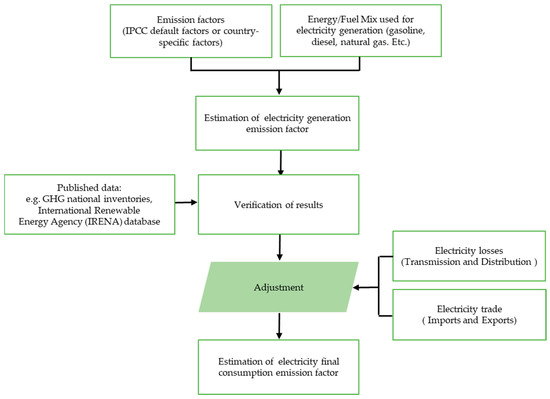
Figure 4.
The methodology used to estimate the electricity emission factor at the point of final consumption.
This factor should account for the below-described elements.
- (i)
- Electricity generation mix: GHGEs from a single electricity generation point depend on the mix used for electricity generation at that point (fossil fuels, biofuels, geothermal, nuclear, solar. etc.); as a result, the emission factor of electricity generation varies from a year to another with the variation of the generation mix. According to the 2006 IPCC Guidelines and the IEA World Energy Balances data [44], the total CO2 emission factor for electricity generation was calculated as follows:where CO2 kWh is the carbon dioxide emission factor (in CO2/kWh) calculated at the generation point, ∑fuels is the sum of the different fuels used for electricity generation, and Inputplants is the fuel input into the plants (both main activity and auto producer) expressed in energy unit. , where CHP denotes the combined heat and power plants. ηheat is the efficiency of heat generation, which is usually assumed 90% similar to that of a typical heat boiler, except when the observed efficiency of CHP generation is higher than 90%, in which case emissions are allocated using the proportionality approach such that inputs are allocated on the basis of the output shares of electricity and heat, where equivalent efficiency is used for both electricity and heat [44]. . EFfuel is default emission factor of the corresponding fuel provided in the 2006 IPCC Guidelines. EleInland is the electricity generated from all sources including the non-emitting sources.
- (ii)
- Electricity trade: a country can either export or import electricity to/from another one. Thus, the emission factor should be adjusted for the trade of electricity; the adjustment can be positive or negative depending on the share of electricity exports and imports. It is calculated as follows:where CO2 kWhtrade is an adjustment of the carbon factor (in CO2/kWh) for emissions induced by the trade of electricity with partner countries, , where CO2 kWh Partner is the electricity generation emission factor at the partner country., and .
- (iii)
- Electricity transmission and distribution losses: about 5–15% of the electricity transmitted is usually lost through the electricity distribution and transmitting grid, which means that, for each kWh at the consumption point, a higher amount of electricity has to be generated to account for these losses. In the case of Palestine, the technical losses in electricity were considered to be 12% according to the Palestinian Energy and Natural Resources Authority (PENRA) [26].
The emission factor was adjusted to account for these losses as follows:
where CO2kWhloss is the adjustment (in CO2/kWh) for emissions induced by electricity transmission and distribution losses. , where the total grid is the electricity transmitted through the country grid which equals to the gross generation and imports of electricity minus plants own use.
By adding the adjustments for electricity trade and losses to the calculated electricity emission factor at the generation point, the emission factor for electricity final consumption in Palestine was obtained. The same methodology was used to calculate the N2O and CH4 emission factors at the consumption point. Then, these factors were used to estimate the emissions from the final consumption of electricity by different sectors in Palestine.
GHGEs induced by the consumption of electricity by different sectors in Palestine were calculated using the following equation:
where GHG emissionssector are the emissions of a specific GHG (CO2, N2O, etc.) from a specific sector (households, commerce, public services, etc.) in kg, and Electricity consumptionsector is the consumption of electricity in a specific sector.
To convert the emissions from (g) N2O and CH4 to (g) CO2 equivalent (CO2eq), the 100 year global warming potential (GWP) in the Fourth Assessment Report of the IPCC was used. The 100 year GWP for CH4 and N2O is 25 and 298, respectively. After converting all emissions to (g) CO2eq, the total GHG emissions from electricity consumption were calculated.
3. Results and Discussion
3.1. Fuel
GHGEs from fuel combustion were estimated using local fuel characteristics in Palestine and the default emission factors in the 2006 IPCC guidelines, as explained in Section 2. The total GHGEs from fuel consumption in 2019 were estimated around 3,912,566 tons of CO2eq, which is close to the value estimated by the PCBS (3,457,410 tons of CO2eq) [43]. The difference is attributed to the use of country-specific fuel characteristics in this study instead of the standard values. The emissions were classified by type of fuel as shown in Figure 5. The largest share was for diesel fuel, which was responsible for 2,021,829 tons of CO2eq, representing more than half (52%) of the total GHGEs resulting from fuel combustion in 2019. Gasoline fuel contributed to approximately 18% of the total GHGEs (725,032 tons CO2eq). These values include the amounts of diesel and gasoline which were transformed into electricity at the Gaza power plant and other small electricity generators. Wood/charcoal, and LPG accounted for 11% (439,338 tons of CO2eq) and 14% (531,812 tons of CO2eq) of total emissions, respectively. Other fuels, such as olive cake and fuel oil, had modest amounts of emissions. Since this research was focused on emissions from the energy sector, the emissions from oils and lubricants were not included because they are accounted for the emissions from industrial processes according to the 2006 IPCC guidelines. Concerning bitumen, the use of bitumen does not create emissions of CO2, because all carbon in bitumen is stored permanently [45].

Figure 5.
GHG emissions from the energy sector by fuel type, 2019 (ton CO2eq).
Even when including the amounts of diesel and gasoline which were used in electricity generation in Palestine during 2019 (the imported electricity was not included), the transport sector was found to be the biggest source of GHGEs with about 56% (2,207,834 tons of CO2eq) of total emissions, as illustrated in Figure 6. This sector was responsible for more than 95% (1,505,282 tons of CO2eq) of the emissions resulting from diesel combustion and around 97% (690,308 tons of CO2eq) of gasoline emissions. The total vehicular emissions were very close to those published by the PCBS in 2019 (2,255,170 tons of CO2eq) [43]. The small difference is attributed to using fuel characteristics in Palestine in the current study instead of the standard values used in the PCBS reports. Another study [12] predicted the emissions from the transport sector in Palestine in 2020 based on data from 2014, and the predicted emissions (4,917,021.907 tons of CO2eq) were double the actual emissions estimated by the PCBS in 2020 (2,293,060 tons of CO2eq) [43], which could be attributed to the accuracy of the model used to predict the number of vehicles and kilometres travelled, and the use of emission factors different from the default in the IPCC guidelines.
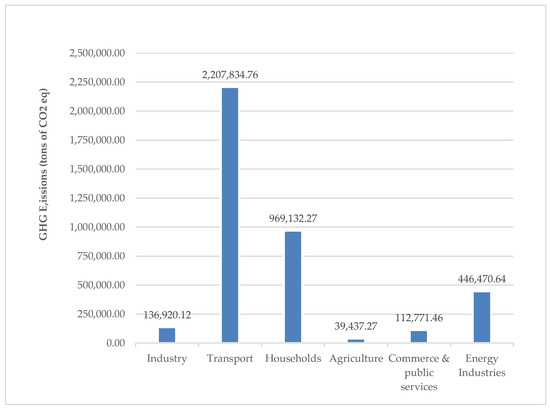
Figure 6.
GHG emissions from final consumption of fuel in 2019, by economic activity, including fuel used for domestic electricity generation (ton CO2eq).
The household sector was the second largest emitter, responsible for around 25% (969,132 tons of CO2eq) of the GHGEs, as shown in Figure 6. This sector was the main consumer of kerosene, wood, charcoal, and olive cake, used for heating houses and water heating, and LPG, used for cooking. The household sector contributed to more than 70% of the GHGEs resulting from the consumption of these fuels.
Not surprisingly, the energy industry’s share of total emissions represented by electricity generation was very low (only 11%, 446,470 tons CO2eq) compared to other countries worldwide. This result is due to the low capacity of electricity generation in Palestine, due to the occupation’s practices including (i) the Israeli control of the Palestinian borders for logistical and political reasons (thus, all types of liquid fuel available for consumption in Palestine, especially diesel and gasoline, are imported from or via Israel, while even the amounts of the fuels are controlled and fuel imports are sometimes banned, particularly on the Gaza Strip where the power plant exists), (ii) the deprivation of the Palestinians from their rights to benefit from the available energy sources such as Gaza’s offshore natural gas field, and (iii) the inability of Palestinians to develop the energy infrastructure and built new power plants without Israel’s approval, altogether aimed at enforcing the Palestinian dependency.
The industry/commerce and public services sectors contributed to about 4% (136,920 tons of CO2eq) and 3% (112,771 tons of CO2eq) of the GHGEs, respectively (Figure 6). This result was expected because Palestine is not considered an industrial country. Banning the Palestinians from importing equipment, machines, and dual-use materials has a significant impact in limiting the ability of the Palestinian economy to improve and expand, which has resulted in the Palestinian economy being dominated by internal trade at the expense of productive and manufacturing sectors [46]. In neighbouring countries with a similar situation but without any restrictions, such as Lebanon, the contributions of the manufacturing and commerce sectors to total emissions from the energy sector are more than 20% and 10%, respectively [47]. Similar results for the contribution of different sub-sectors to total GHGEs from the energy sector in Palestine in 2016 were recorded by Qureitem et al. (2019). The transport sector dominated emissions from the energy sector with 58%, followed by households with 29%, electricity generation with 8%, commerce and public services with 2%, manufacturing industries with 2%, and agriculture with 1% [10]. However, even though the percentages are very close, the total GHGEs from the energy sector in 2016 were 4,131,550 tons of CO2eq, greater than the emissions in 2016 published by the PCBS in the reports of emissions to air tables (3,381,790 tons of CO2eq) [43] and total GHGEs in 2019 estimated in this research (3,912,566 tons of CO2eq). The emissions of 2019 were expected to be higher than those estimated in 2016 by Qureitem et al. (2016) due to the natural increasing consumption of energy as a result of population growth, and the growing use of transportation; however, this was not the case. Simultaneously, Qureitem et al.’s (2019) results were slightly higher than those estimated by the PCBS for the same year (2016) for no clear reason, despite both references using the same emission factors and energy tables in their estimations (energy consumption data).
3.2. Electricity
The emission factors of GHGs for electricity generation were calculated for the period 2011–2020 according to the IPCC 2006 guidelines using the fuel default emission factors presented in Table 2. Table 3 shows that the emission factors of CO2 and other GHGs varied from year to year, due to the variation of the fuel mix, i.e., the amount and type of fuel used to generate electricity from 1 year to another. Here, other factors influencing GHG emission factors for electricity generation such as quality of fuel, pollution control technologies, and power plant efficiency were not taken into account due to a lack of information in the study area.

Table 2.
Default GHG emission factors for fuel combustion according to the 2006 IPCC guidelines.

Table 3.
GHG emission factors of electricity generation, total emissions from electricity generation, and per capita electricity generation in Palestine for the period 2011–2020.
The results were compared to published reports and the literature, such as the Palestinian National Inventory and the statistics of the International Renewable Energy Agency (IRENA) [36,43]. The small differences between the estimated emission factors and emission factors in other references were attributed to using the density of diesel and gasoline fuel in Palestine in this research, converting the amount of fuel from physical units to energy units instead of using standard values.
The calculated emission factors were used to estimate GHGEs from the electricity generation in Palestine during the same period, as shown in Table 3. The per capita electricity generation was also estimated. There was a variation in the total GHGEs and, accordingly, the emissions per capita, from 1 year to another, which could be attributed to the variation in the amount of fuel used in electricity generation. This was mainly a result of the blockade and the control of Israel over the fuel supply (reducing/cutting off the diesel supply). For instance, in 2014 and 2018, when the lowest emissions were recorded, the Gaza power plant was hit several times by Israeli shelling during the 2014 war. It was temporarily forced to shut down [48]. Moreover, in 2018, Israel banned the entry of gas and fuel to the Gaza Strip [49].
Since the electricity generation in Palestine represents an insignificant proportion of the total electricity supply (about 10%), Palestine’s per capita electricity generation is highly below other countries in the area, as illustrated in Figure 7. The capacity of electricity generation is limited in Palestine because the only current significant electricity domestic supply, the Gaza power plant, has been facing major hindrances apart from the occupation control on the fuel supply. It faces financial problems in covering the high cost of diesel fuel by the Palestinian institutions without the support of international donors which has been declining in the past few years, and the repeated damage of many facilities of the power plant during the armed conflict [27]. Altogether, this has led to a typical operation of the power plant at less than 50% of its capacity.
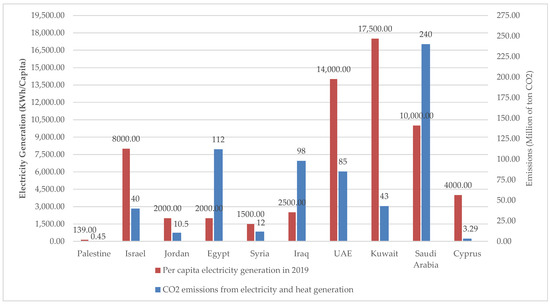
Figure 7.
GHG emissions from electricity generation and electricity generation per capita in Palestine and other countries in 2019. Data for other countries were obtained from energy profiles published online at IRENA website [35].
The calculated electricity generation factors for the period 2011–2020 were adjusted for electricity trade and losses to estimate the electricity emission factors at the final consumption point. As shown in Table 4, the factor varied from year to year due to the variations in the energy mix used for electricity generation. The Mann–Kendall test was used to check whether the decreasing trend in the electricity generation factors in Palestine and Israel over 2011–2021 was statistically significant. The result of the test is illustrated in Figure 8. It shows that the decreasing trend was statistically significant at the 0.001 level. On the Israeli side, this decrease was due to the major shift in the electricity generation mix from coal to natural gas in Israel; the share of natural gas in the fuel mix increased over the years from 35% in 2011 to 67% in 2020 [38]. On the other hand, the fuel mix for electricity production in Palestine has not changed significantly over the past years. The decreasing trend in the electricity generation emission factor was attributed to the amount of generated electricity (see Table 3), which depends on the fuel supply allowed to enter the country.

Table 4.
Emission factors of electricity consumption in Palestine for the period 2011–2020.
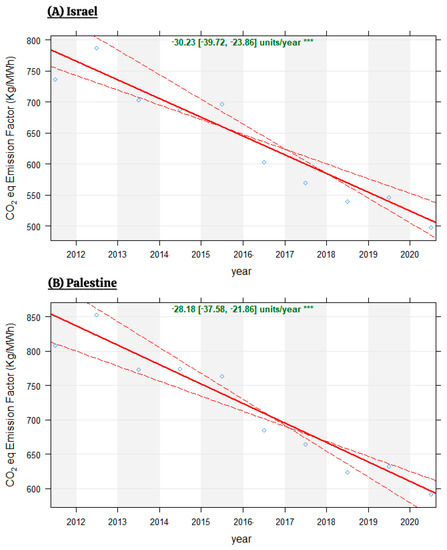
Figure 8.
Trend in the CO2 electricity generation emission factors in (A) Israel and (B) Palestine during the period 2011–2021. The solid red line represents the mean trend, and the dashed lines represent the 95% confidence intervals. The trends and confidence intervals are shown at the top as vehicles/year. *** Significant at the 0.001 level.
GHGEs from the electricity sector were estimated for 2019 using the electricity generation emission factors for the country where the electricity was produced. The vast majority of the emissions (about 3,405,441.36 tons of CO2eq; 88%) were from imported electricity, while <12% (446,470.64 tons of CO2eq) were from domestic generated electricity, mainly from the Gaza power plant (Figure 9).
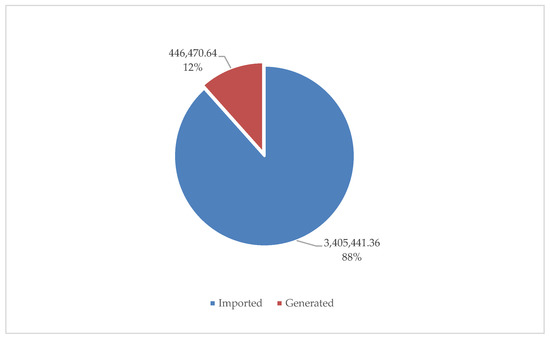
Figure 9.
GHG emissions from the electricity sector, 2019 (tons of CO2eq).
The electricity emission factors at the final consumption point were also estimated by economic activity for the year 2019. The results are presented in Figure 10. The total GHGEs from electricity consumption were 3,929,829 tons of CO2eq. The highest emissions from electricity consumption were from the household sector (about 59% of electricity consumption emissions; 2,316,465 tons of CO2eq), which is the largest electricity consumer in Palestine, where electricity is used for lighting, heating, cooling, appliances, cooking, etc. The only available study concerning GHGEs from electricity consumption (including imported electricity) by the household sector in Palestine estimated about 1,512,791 tons of CO2eq to be associated with electricity consumption in 2010 [11]. The estimation of GHGEs was based on the average household energy consumption and number of households in the West bank, as well as the emission factors in China (e.g., the emission factor of CO2 electricity consumption was 307 kg/MWh) [11]. The calculated emissions from electricity consumption in this study in 2019 were three times greater than those estimated in 2010 by Abu-Madi et al. (2013) [11], which is reasonable as a result of the increase in electricity consumption due to population growth and higher estimated values of electricity consumption emission factors in Palestine, as illustrated in Table 4.
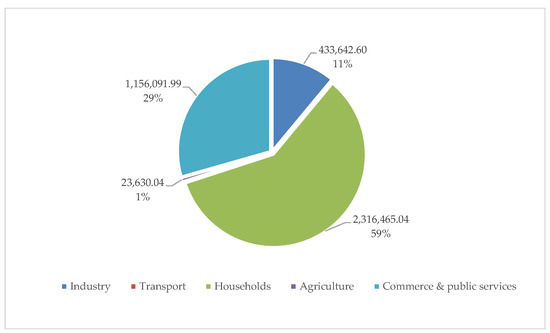
Figure 10.
GHG emissions from electricity consumption, 2019 (ton CO2eq).
The household sector was followed by the commerce and public services sector, which accounted for around 29% (1,156,091 tons of CO2eq) of the total GHGEs from consumed electricity, including commercial buildings such as shops, offices, restaurants, and public buildings and services such as hospitals, schools, universities, and street lighting.
The industrial sector accounted for only 11% (433,642 tons CO2eq) of the emissions from electricity consumption, while the agricultural sector accounted for only 1% (23,630 tons of CO2eq). It can be seen that the emissions from the transportation sector due to electricity consumption were negligible because the proportion of electrical and hybrid vehicles in Palestine in 2019 was <0.5% of the total vehicle fleet [32].
3.3. Total GHGEs
Usually, the emissions from purchased electricity and heat covered under scope 2 emissions are not considered in national inventories of GHGEs. In the case of Palestine’s national inventory, even though most of the electricity is purchased, the national inventory only accounts for domestic electricity generation. The emissions associated with imported electricity reside on the supplier side (mainly Israel, as referenced in the Palestinian National Inventory Report) [16]. This research analysed the impact of including imported electricity on the estimation of GHGEs.
Without taking the imported electricity into account, the total emissions from the energy sector in Palestine during 2019 were 3,912,566 tons of CO2eq. Diesel fuel had the largest share (above 40%; 1,591,030 tons of CO2eq) of the total emissions, followed by gasoline and LPG fuels, as shown in Figure 11. Electricity accounted for only 11% (446,470 tons of CO2eq) of the GHGEs. Including the imported electricity in the estimation of the GHGEs doubled the total emissions of the energy sector to reach 7,395,925 tons of CO2eq. Consequently, the electricity share grew from 11% to more than half of the total GHGEs from the energy sector (53%, 3,929,829 tons of CO2eq), making electricity consumption the main source of GHGEs in Palestine. The shares of diesel and gasoline fuels fell to 21% (1,591,030 tons of CO2eq) and 10% (709,359 tons of CO2eq), respectively, as illustrated in Figure 11.
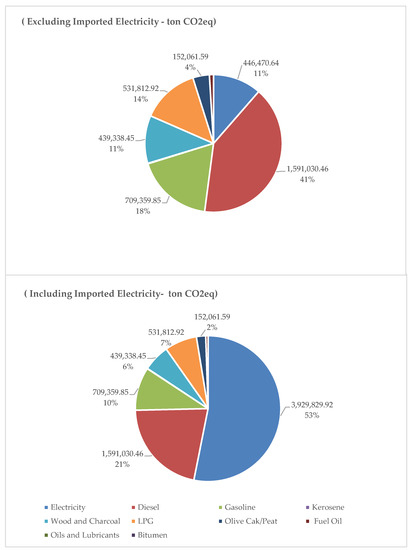
Figure 11.
Total GHG emissions from the energy sector in 2019: ‘energy industries, industry, transportation and households and other sectors’, including and excluding imported electricity (in tons of CO2eq).
Including the imported electricity also affected the contribution of economic activities to the total GHGEs, as illustrated in Figure 12. The household sector contributed to approximately 45% (3,285,597 tons of CO2eq) of the total emissions. The second largest emitter was the transport sector, which represented a share of 30% (2,207,834 tons of CO2eq). The shares of other sectors also increased at the expense of the transport sector.
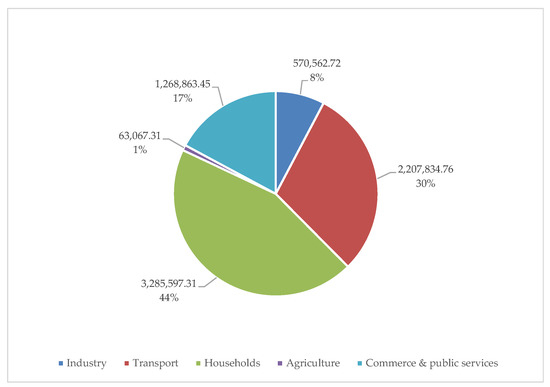
Figure 12.
Total GHG emissions from final consumption of energy in 2019 by economic activity, including imported electricity (in ton CO2eq).
In terms of the type of GHGs, the vast majority of emissions from the energy sector were released as CO2 (98% of total GHGE- 7,259,947 tons of CO2eq), as shown in Table 5.

Table 5.
Total emissions from final consumption of energy in 2019 by type of GHG, including imported electricity.
3.4. GHGEs per Capita
The per capita emissions are calculated by dividing the emissions of a country by its population. Figure 13 shows the emissions per capita from the energy sector and by economic activity in Palestine and other countries in 2019. To make the results comparable across countries, scope 2 emissions resulting from imported electricity were not included. The highest per capita emissions were recorded in oil-producing countries such as Saudi Arabia, Kuwait, and UAE. While Palestine showed the lowest emissions per capita, the emissions from the energy sector are less than 0.8 ton of CO2eq/capita. Contrary to all other countries, the per capita emissions from electricity generation in Palestine were the lowest among other economic activities due to the limited capacity of electricity generation.
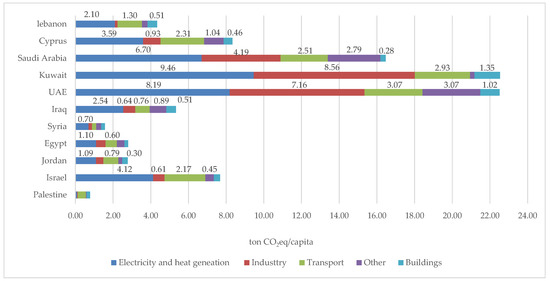
Figure 13.
Per capita GHGEs from the energy sector in Palestine and other countries during 2019. Data for other countries on total emissions from energy profiles published online at IRENA website [35].
The effect of including scope 2 emissions in the calculations was also analysed. As illustrated in Figure 14, including the emissions from imported electricity increased the per capita emissions related to energy from 0.79 to 1.49 tons CO2eq/capita, which is approximately twice the GHGEs. On one hand, emissions from electricity generation and the transport sector were not affected, whereas the per capita GHGEs from the household sector and commerce and public services increased by more than three times and 12 times, respectively.
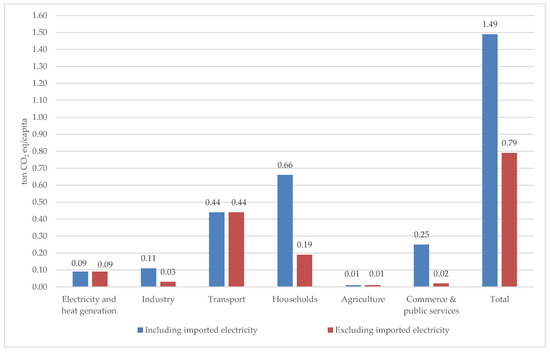
Figure 14.
Per capita GHGEs from the energy sector in Palestine including and excluding imported electricity in 2019.
4. Conclusions
This research was aimed at investigating the GHGEs of the energy sector in a territory suffering from geopolitical tension, Palestine. The methodology for estimating the carbon emissions was based on the 2006 IPCC guidelines (more precisely, the Tier 1 approach), because the country-specific emission factors were unavailable.
Analysis showed that the Israeli occupation influenced the Palestinian GHGEs as follows: (i) Israeli control of the Palestinian borders and import of fuel, (ii) deprivation of the Palestinians of their rights to benefit from the available energy sources, and (iii) inability of Palestinians to develop the energy sector, which has limited the capacity of electricity generation and consequently affected the emission factors of electricity generation and consumption.
The impact of the imported electricity in estimating GHG emissions was assessed. It doubled the total emissions of the energy sector. The household sector became the largest contributor to the GHG emissions instead of the transport sector. The dependency of Palestine on imported electricity has led to reducing the emissions from electricity consumption since the electricity consumption emission factors on the Israeli side are lower than the Palestinian side due to the use of emission control technology and a less polluted electricity mix, which is not possible in Palestine because of discriminatory practices.
Furthermore, banning the Palestinians from importing the necessary equipment, machines, and dual-use materials has a significant impact on limiting the ability of the Palestinian economy to improve and expand, which in turn reduces the CO2 emissions from the industry/commerce and public service sectors (about 4% and 3% of the GHGEs, respectively). In neighbouring countries with a similar situation but without any restrictions, such as Lebanon, the shares of these sectors account for more than 20% and 10%, respectively.
The main limitation of this research was related to data availability, as country-specific emission factors were not available. Moreover, other data were missing, such as fuel consumption and vehicle kilometres travelled by type of vehicle, due to poor data collection and archiving systems in the country. Consequently, it was necessary to make assumptions about some missing information, as detailed in Section 2.
Reducing the GHGEs in Palestine should focus on the transport and household sectors, which constitute the major contributors to these emissions. This objective requires a public policy, international support, and private and public efforts to (i) increase the production of solar-based renewable energy for hot water and electricity generation, (ii) improve the buildings’ energy performances, (iii) improve the public transport and the quality of vehicles in Palestine, and (iv) reduce the dependency on the imported electricity by developing electricity generation capacity from green sources through public–private partnership.
Author Contributions
Conceptualisation, H.A.J. and I.S.; methodology, H.A.J., I.S. and H.M.; data collection and analysis, H.A.J.; writing, H.A.J. and I.S.; review, H.M. All authors have read and agreed to the published version of the manuscript.
Funding
This research received no external funding.
Institutional Review Board Statement
Not applicable.
Informed Consent Statement
Not applicable.
Data Availability Statement
Data were obtained from official websites of the Palestinian Central Bureau of Statistics (BCBS), Palestinian Energy and Natural Resources Authority (PENRA), Palestinian Ministry of Transport in The West Bank and Gaza Strip (MoT), International Renewable Energy Agency (IRENA), and Israel Ministry of Environmental Protection. Data are available online to everyone, and the exact references can be found in Table 1 in the main text.
Conflicts of Interest
The authors declare no conflict of interest.
References
- Freij, L. Climate Change and the Vulnerable Occupied Palestinian Territories. UCLA J. Environ. Law Policy 2021, 39, 65. [Google Scholar] [CrossRef]
- Kouyakhi, N.R. CO2 Emissions in the Middle East: Decoupling and Decomposition Analysis of Carbon Emissions, and Projection of Its Future Trajectory. Sci. Total Environ. 2022, 845, 157182. [Google Scholar] [CrossRef] [PubMed]
- Imran, M.; Khan, S.; Jambari, H.; Musah, M.B.; Zaman, K. War Psychology: The Global Carbon Emissions Impact of the Ukraine-Russia Conflict. Front. Environ. Sci. 2023, 11, 228. [Google Scholar] [CrossRef]
- Zhang, C.; Hu, Q.; Su, W.; Xing, C.; Liu, C. Satellite Spectroscopy Reveals the Atmospheric Consequences of the 2022 Russia-Ukraine War. Sci. Total Environ. 2023, 869, 161759. [Google Scholar] [CrossRef] [PubMed]
- AL-wesabi, I.; Zhijian, F.; Bosah, C.P.; Dong, H. A Review of Yemen’s Current Energy Situation, Challenges, Strategies, and Prospects for Using Renewable Energy Systems. Environ. Sci. Pollut. Res. 2022, 29, 53907–53933. [Google Scholar] [CrossRef] [PubMed]
- Hainoun, A.; Omar, H.; Almoustafa, S.; Seif-Eldin, M.K.; Meslmani, Y. Future Development of Syrian Power Sector in View of GHG Mitigation Options. Renew. Sustain. Energy Rev. 2014, 38, 1045–1055. [Google Scholar] [CrossRef]
- Hashim, B.M.; Sultan, M.A.; Al Maliki, A.; Al-Ansari, N. Estimation of Greenhouse Gases Emitted from Energy Industry (Oil Refining and Electricity Generation) in Iraq Using IPCC Methodology. Atmosphere 2020, 11, 662. [Google Scholar] [CrossRef]
- Michaelowa, A.; Koch, T. Military emissions, armed conflicts, border changes and the kyoto protocol. Clim. Chang. 2001, 50, 383–394. [Google Scholar] [CrossRef]
- Michaelowa, A.; Koch, T.; Charro, D.; Gameros, C.; Burton, D.; Lin, H.-C. Military and Conflict-Related Emissions: Kyoto to Glasgow and beyond Report; Perspective Climate Group: Breisgau, Germany, 2022. [Google Scholar]
- Qureitem, G.; Al-Khatib, I.A.; Anayah, F. Inventory of Main Greenhouse Gas Emissions from Energy Sector in Palestine. Environ. Monit. Assess. 2020, 192, 63. [Google Scholar] [CrossRef]
- Abu-Madi, M.; Rayyan, M.A. Estimation of Main Greenhouse Gases Emission from Household Energy Consumption in the West Bank, Palestine. Environ. Pollut. 2013, 179, 250–257. [Google Scholar] [CrossRef]
- Hassouna, F.M.A.; Al-Sahili, K. Environmental Impact Assessment of the Transportation Sector and Hybrid Vehicle Implications in Palestine. Sustainability 2020, 12, 7878. [Google Scholar] [CrossRef]
- Hassouna, F.M.A.; Al-Sahili, K. Future Energy and Environmental Implications of Electric Vehicles in Palestine. Sustainability 2020, 12, 5515. [Google Scholar] [CrossRef]
- Hassouna, F.M.A.; Assad, M. Towards a Sustainable Public Transportation: Replacing the Conventional Taxis by a Hybrid Taxi Fleet in the West Bank, Palestine. Int. J. Environ. Res. Public Health 2020, 17, 8940. [Google Scholar] [CrossRef] [PubMed]
- Karaeen, M.; Hasan, A.A.; Hanieh, A.A.; Zorba, M.; Abuhomos, M. On-Road Vehicular Emissions Case of Palestine. In Proceedings of the 2021 12th International Renewable Engineering Conference, IREC 2021, Amman, Jordan, 14–15 April 2021; Institute of Electrical and Electronics Engineers Inc.: Piscataway, NJ, USA. [Google Scholar]
- Palestine Environment Quality Authority. Initial National Communication Report to the United Nation Convention on Climate Change; Palestine Environment Quality Authority: Ramallah, Palestine, 2016. [Google Scholar]
- Elahi, E.; Khalid, Z.; Tauni, M.Z.; Zhang, H.; Lirong, X. Extreme Weather Events Risk to Crop-Production and the Adaptation of Innovative Management Strategies to Mitigate the Risk: A Retrospective Survey of Rural Punjab, Pakistan. Technovation 2022, 117, 102255. [Google Scholar] [CrossRef]
- Elahi, E.; Khalid, Z.; Zhang, Z. Understanding Farmers’ Intention and Willingness to Install Renewable Energy Technology: A Solution to Reduce the Environmental Emissions of Agriculture. Appl. Energy 2022, 309, 118459. [Google Scholar] [CrossRef]
- Solomon, S.; Plattner, G.-K.; Knutti, R.; Friedlingstein, P. Irreversible Climate Change Due to Carbon Dioxide Emissions. Proc. Natl. Acad. Sci. USA 2009, 106, 1704–1709. [Google Scholar] [CrossRef]
- Drouet, J.-L.; Capian, N.; Fiorelli, J.-L.; Blanfort, V.; Capitaine, M.; Duretz, S.; Gabrielle, B.; Martin, R.; Lardy, R.; Cellier, P.; et al. Sensitivity Analysis for Models of Greenhouse Gas Emissions at Farm Level. Case Study of N2O Emissions Simulated by the CERES-EGC Model. Environ. Pollut. 2011, 159, 3156–3161. [Google Scholar] [CrossRef]
- Abbas, A.; Zhao, C.; Waseem, M.; Ahmed khan, K.; Ahmad, R. Analysis of Energy Input–Output of Farms and Assessment of Greenhouse Gas Emissions: A Case Study of Cotton Growers. Front. Environ. Sci. 2022, 9, 826838. [Google Scholar] [CrossRef]
- United Nations High Commissioner for Human Rights. Human Rights Council Forty-Eighth Session: The Allocation of Water Resources in the Occupied Palestinian Territory, Including East Jerusalem; United Nations High Commissioner for Human Rights: Geneva, Switzerland, 2020. [Google Scholar]
- European Union. Six-Month Report on Israeli Settlements in the Occupied West Bank, Including East Jerusalem Reporting Period; European Union: Maastricht, The Netherlands, 2021. [Google Scholar]
- Ramahi, S. The Environmental Impact of Israeli Settlements on the Occupied Palestinian Territories. 2012. Available online: https://www.middleeastmonitor.com/20140511-the-environmental-impact-of-israeli-settlements-on-the-occupied-palestinian-territories/ (accessed on 15 April 2023).
- United Nations Environment Programme. State of Environment and Outlook Report for the Occupied Palestinian Territory 2020; United Nations Environment Programme: Nairobi, Kenya, 2020. [Google Scholar]
- Palestinian Central Bureau of Statistics. Energy Tables and Energy Balance 2019. 2020. Available online: https://www.pcbs.gov.ps/Portals/_Rainbow/Documents/energy2019ArEn.pdf (accessed on 10 December 2022).
- World Bank Groupe. Securing Energy for Development in West Bank and Gaza. 2017. Available online: https://documents1.worldbank.org/curated/en/351061505722970487/pdf/Replacement-MNA-SecuringEnergyWestBankGaza-web.pdf (accessed on 15 October 2022).
- Palestine Environment Quality Authority. The State of Palestine’s First Nationally Determined Contributions (NDCs) “Updated Submission”. 2021. Available online: https://unfccc.int/sites/default/files/NDC/2022-06/Updated%20NDC_%20State%20of%20Palestine_2021_FINAL.pdf (accessed on 10 October 2022).
- Palestinian Energy and Natural Resources Authority. Palestinian Energy and Natural Resources Authority Website. 2023. Available online: http://penra.gov.ps/ (accessed on 3 January 2023).
- Palestinian Central Bureau of Statistics. Annual Energy Tables and Energy Balance. 2022. Available online: https://www.pcbs.gov.ps/site/lang__en/1030/Default.aspx (accessed on 9 February 2023).
- Palestinian Ministry of Transport. Palestinian Ministry of Transport: Statistics. 2022. Available online: http://www.mot.gov.ps/statistics-2/ (accessed on 15 March 2023).
- Palestinian Ministry of Transport. Transport Sector: Annual Statistical Report 2019. 2020. Available online: http://www.mot.gov.ps/wp-content/uploads/Portals/_Rainbow/Documents/Stats/Annual_Repoert2019.pdf (accessed on 20 October 2022).
- Gaza Ministry of Transport. Report on the Achievements of the Ministry of Transport in Gaza Strip. 2019. Available online: https://www.mot.ps/site/2020/02/26/%d8%aa%d9%82%d8%b1%d9%8a%d8%b1-%d8%a5%d9%86%d8%ac%d8%a7%d8%b2%d8%a7%d8%aa-%d9%88%d8%b2%d8%a7%d8%b1%d8%a9-%d8%a7%d9%84%d9%86%d9%82%d9%84-%d9%88%d8%a7%d9%84%d9%85%d9%88%d8%a7%d8%b5%d9%84%d8%a7%d8%aa-2/ (accessed on 15 March 2023).
- Intergovernmental Panel on Climate Change. 2006 IPCC Guidelines for National Greenhouse Gas Inventories. 2006. Available online: https://www.ipcc-nggip.iges.or.jp/public/2006gl/index.html (accessed on 15 March 2022).
- International Renewable Energy Agency. Statistical Profiles. 2022. Available online: https://www.irena.org/Data/Energy-Profiles (accessed on 10 May 2023).
- International Renewable Energy Agency. Palestine Energy Profile. 2022. Available online: https://www.irena.org/-/media/Files/IRENA/Agency/Statistics/Statistical_Profiles/Middle-East/State-of-Palestine_Middle-East_RE_SP.pdf?rev=d73c2ae76f8a48e484705ff50dc77ea1 (accessed on 10 May 2023).
- Israel Ministry of Environmental Protection. System for Recording Greenhouse Gas Emissions in Israel, Operating Regulations and Reporting Guidelines; Israel Ministry of Environmental Protection: Jerusalem, Israel, 2022.
- Gutglick, I.; Nehenia, L.; Mekonen, S.; Aran, M.; Semah, S. Report on the State of the Electricity Sector|2020. 2020. Available online: https://www.gov.il/en/departments/publications/reports/yearly_reports_pua_db_eng (accessed on 9 February 2023).
- Abu Hamed, T.; Ismail, L.; Alshare, A. The Potential of Using Olive Cake in Power Generation in the Palestinian Territories. Int. J. Sustain. Energy 2017, 36, 368–378. [Google Scholar] [CrossRef]
- Khraisha, Y.H. Energetic Study on Jordanian Olive Cake and Woody Biomass Materials. J. Power Energy Eng. 2022, 10, 1–13. [Google Scholar] [CrossRef]
- Tawarah, K.M.; Rababah, R.A. Characterization of Some Jordanian Crude and Exhausted Olive Pomace Samples. Green Sustain. Chem. 2013, 03, 146–162. [Google Scholar] [CrossRef]
- Karaeen, M.; El-Khateeb, I.; Jaradat, A.; Samara, M.; Bannoura, M. Fuel Quality Implications on Combustion Engines in the West Bank Area of Palestine; Palestine Polytechnic University: Hebron, Palestine, 2013. [Google Scholar]
- Palestinian Central Bureau of Statistics. Emissions to Air Tables. 2020; Ramallah—Palestine. 2022. Available online: https://www.pcbs.gov.ps/Portals/_Rainbow/Documents/Emissions_2020_01.html (accessed on 13 November 2022).
- International Energy Agency. Emission Factors 2020 Database Documentation. 2020. Available online: https://iea.blob.core.windows.net/assets/8f05b8a2-e2e4-46a4-a4f9-c03163484501/CO2KWH_Methodology.pdf (accessed on 15 November 2022).
- Krtková, E.; Danielik, V.; Szemesová, J.; Tarczay, K.; Kis-Kovács, G.; Neuzil, V. Non-Energy Use of Fuels in the Greenhouse Gas Emission Reporting. Atmosphere 2019, 10, 406. [Google Scholar] [CrossRef]
- Shikaki, I. The Demise of Palestinian Productive Sectors: Internal Trade as a Microcosm of the Impact of Occupation; Palestine Liberation Organization: Jerusalem, Palestine, 2021. [Google Scholar]
- MoE/UNDP/GEF. Lebanon’s Second Biennial Update Report to the UNFCCC Ministry of Environment Beirut, Lebanon. 2017. Available online: https://unfccc.int/sites/default/files/resource/3490185_Lebanon-BUR2-1-Lebanon%20BURII%202017.pdf (accessed on 5 June 2023).
- Euro-Mediterranean Partnership Unit. Background Note on Energy and Water Issues in Palestine. 2019. Available online: https://www.europarl.europa.eu/meetdocs/2014_2019/documents/dpal/dv/background_note_hala/background_note_halaen.pdf (accessed on 23 November 2022).
- Martin, A.; Barhoum, L.; Dikomitis, E.; Gorevan, D. Israel Tightens Gaza Blockade, Civilians Bear the Brunt Tightening Restrictions. 2018. Available online: https://www.oxfam.org/en/research/israel-tightens-gaza-blockade-civilians-bear-brunt (accessed on 17 March 2023).
Disclaimer/Publisher’s Note: The statements, opinions and data contained in all publications are solely those of the individual author(s) and contributor(s) and not of MDPI and/or the editor(s). MDPI and/or the editor(s) disclaim responsibility for any injury to people or property resulting from any ideas, methods, instructions or products referred to in the content. |
© 2023 by the authors. Licensee MDPI, Basel, Switzerland. This article is an open access article distributed under the terms and conditions of the Creative Commons Attribution (CC BY) license (https://creativecommons.org/licenses/by/4.0/).